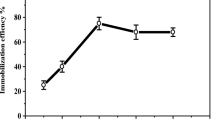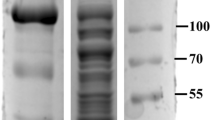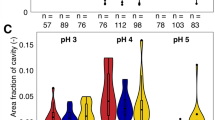Abstract
We have developed a novel immobilization medium by soaking enzyme-containing calcium alginate beads in a solution of tetramethoxy-ortho-silicate (TMOS) in hexane. Water-soluble alkyl siloxanes, resulting from the partial hydrolysis of TMOS at the hexane-water interface permeated the alginate gel, polymerized and formed a colloid within the beads. Silicate-alginate beads were robust, and did not deform under pressure. The composite gel demonstrated the excellent protein retention and thermal stabilization properties typical of silicate sol-gel-immobilization, as well as protection against inactiva-tion by concentrated urea solutions. Immobilized β-glucosidase had complete operational stability at ambient temperature for at least several months.
This is a preview of subscription content, access via your institution
Access options
Subscribe to this journal
Receive 12 print issues and online access
$209.00 per year
only $17.42 per issue
Buy this article
- Purchase on Springer Link
- Instant access to full article PDF
Prices may be subject to local taxes which are calculated during checkout
Similar content being viewed by others
References
Braun, S., Rappoport, S., Zusman, R., Avnir, D. and Ottolenghi, M. 1990. Biochemically active sol-gel glasses: The trapping of enzymes. Mat. Lett. 10: 1–5.
Shtelzer, S., Rappoport, S., Avnir, D., Ottolenghi, M. and Braun, S. 1992. Properties of trypsin and of acid phosphatase immobilized in sol-gel glass matrices. Biotechnol. Appl. Biochem. 15: 227–235.
Braun, S., Shtelzer, S., Rappoport, S., Avnir, D. and Ottolenghi, M. 1992. Biocatalysis by sol-gel entrapped enzymes. J. Non-Cryst. Solids 147&148: 739–743.
Edmiston, P.L., Wambolt, C.L., Smith, M.K. and Saavedra, S.S. 1994. Spectroscopic characterization of albumin and myoglobin entrapped in bulk sol-gel glasses. J. Colloid Interface Sci. 163: 395–406.
Shtelzer, S. and Braun, S. 1994. Optical biosensor based upon glucose oxidase immobilized in sol-gel silicate matrix. Biotechnol. Appl. Biochem. 19: 293–305.
Avnir, D., Braun, S., Lev, O. and Ottolenghi, M. 1994. Enzymes and other proteins entrapped in sol-gel materials. Chem. Mater. 1994: 1605–1614.
Berezin, I.V., Klibanov, A.M. and Martinek, K. 1975. Kinetic and thermodynamic aspects of catalysis by immobilized enzymes. Usp. Khim. (Rus) 44: 17–47.
Plank, P.F.H. and Zent, J.B. 1992. Use of enzymes in wine making and grape processing, p. 181–196. In: Beer and Wine Production. Gump, B. H. (Ed.). ACS Symp. Ser. Vol. 536.
Bakul, C.D., Dunn, B., Valentine, J.S. and Zink, J.I. 1994. Sol-gel encapsulation methods for biosensors. Anal. Chem. 66: 1120A–1127A.
Livage, J., Barreau, J.Y., Da Costa, J.M. and Desport, I. 1994. Optical detection of parasitic protozoa in sol-gel matrices. SPIE Proc. 2288: 493–503.
Author information
Authors and Affiliations
Rights and permissions
About this article
Cite this article
Heichal-Segal, O., Rappoport, S. & Braun, S. Immobilization in Alginate-Silicate Sol-Gel Matrix Protects β-Glucosidase Against Thermal and Chemical Denaturation. Nat Biotechnol 13, 798–800 (1995). https://doi.org/10.1038/nbt0895-798
Received:
Accepted:
Issue Date:
DOI: https://doi.org/10.1038/nbt0895-798
This article is cited by
-
Synthesis of silica–alginate nanoparticles and their potential application as pH-responsive drug carriers
Journal of Sol-Gel Science and Technology (2019)
-
Immobilization of Fusarium graminearum β-d-fructofuranosidase using alternative cellulosic supports: Stabilization and production of fructooligosaccharides
Food Science and Biotechnology (2015)
-
Fiber-optic glucose biosensor based on glucose oxidase immobilised in a silica gel matrix
Journal of Sol-Gel Science and Technology (2009)
-
Esterification of lauric acid using lipase immobilized in the micropores of a hollow‐fiber membrane
Journal of the American Oil Chemists' Society (2006)
-
Silica–alginate composites for microencapsulation
Applied Microbiology and Biotechnology (2003)



